
Ray Swanson, CA
(1937-2004)
Whatever the subject matter of his paintings, Ray Swanson revealed something of himself as well. His own story, however, explains much about how the man behind the canvas achieved the dream that so many artists share.
Ray’s childhood and early years reveal how his artistic heritage and rural upbringing molded him into the artist that he became. Ray was able to do for a living what he loved most during his lifetime of 67 years before his untimely death on December 17, 2004.
Source: Ray Swanson

Young Mr. Begay
Artist: Ray Swanson, CA (1937-2004)
Description: Mixed Media (1991) | Image Size: 8”h x 10”w; Framed Size: 16 ½”h x 18 ½”wpainting
This is a small, but exquisite portrait of one of Ray Swanson’s favorite models, Jason Begay, who at the time this piece was completed was the only boy in a family
of five sisters who has handsome, classic Navajo features and loves to model.
Swanson’s technique of drawing the boy’s face, hair, and hands in pencil and then contrasting those areas with a vibrant turquoise blue bandana and traditional Navajo
velvet shirt adds tremendous depth to the facial features. We focus on Jason’s face even more so because the blue serves to frame it. The young man’s personality and emotions have been expertly captured.
“Young Mr. Begay” made its debut at the 26th
Annual Cowboy Artists of America Show & Sale held at the Phoenix Art Museum in 1991. It was subsequently purchased by Eddie Basha at an auction in 2005.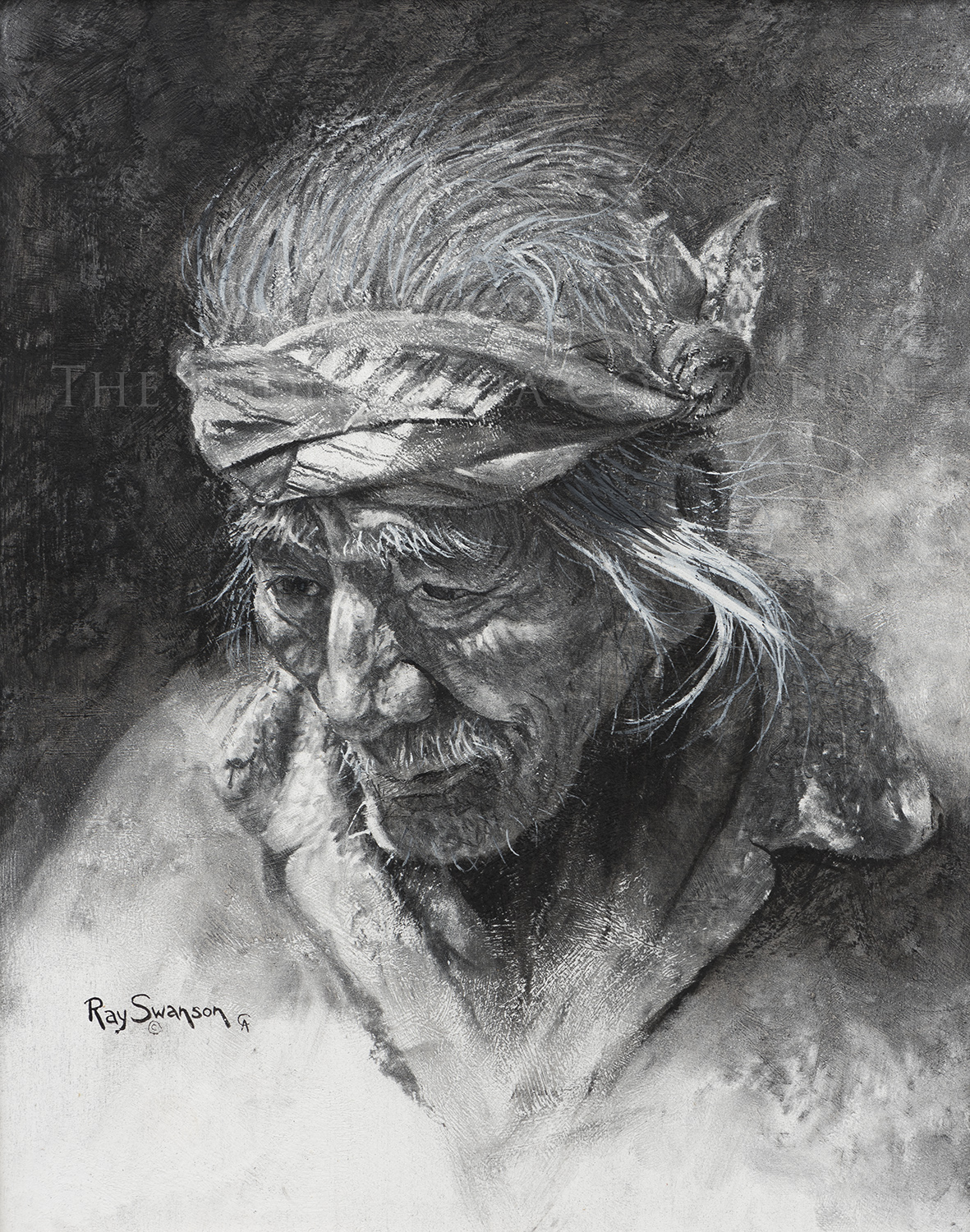
Unknown Title
Artist: Ray Swanson, CA (1937-2004)
Description: Gouache | Image Size: 15”h x 12”w; Framed Size: 23”h x 20”wpainting
Cowboy Artists of America Member Ray Swanson’s black and white study of a Navajo elder is an excellent example of Swanson’s ability to capture personality and character by concentrating on facial features presenting a somber, but dignified demeanor. With the subject’s head cast downward, the viewer sees a full view of his hair, headwrap and a many-seasoned face.
Navajo From Dennehotso
Artist: Ray Swanson, CA (1937-2004)
Description: Oil | Image Size: 18”h x 24”w; Framed Size: 28”h x 34”wpainting
Ray Swanson said on many occasions that his greatest challenge and greatest reward was to capture the many emotions and experiences expressed in the faces of his subjects. In this profile portrait of a Navajo man wearing a traditional hat and turquoise jewelry, Swanson met that challenge. His portrayal of this senior citizen captured not only the gentleman’s dignity, but his lifetime of unique experiences.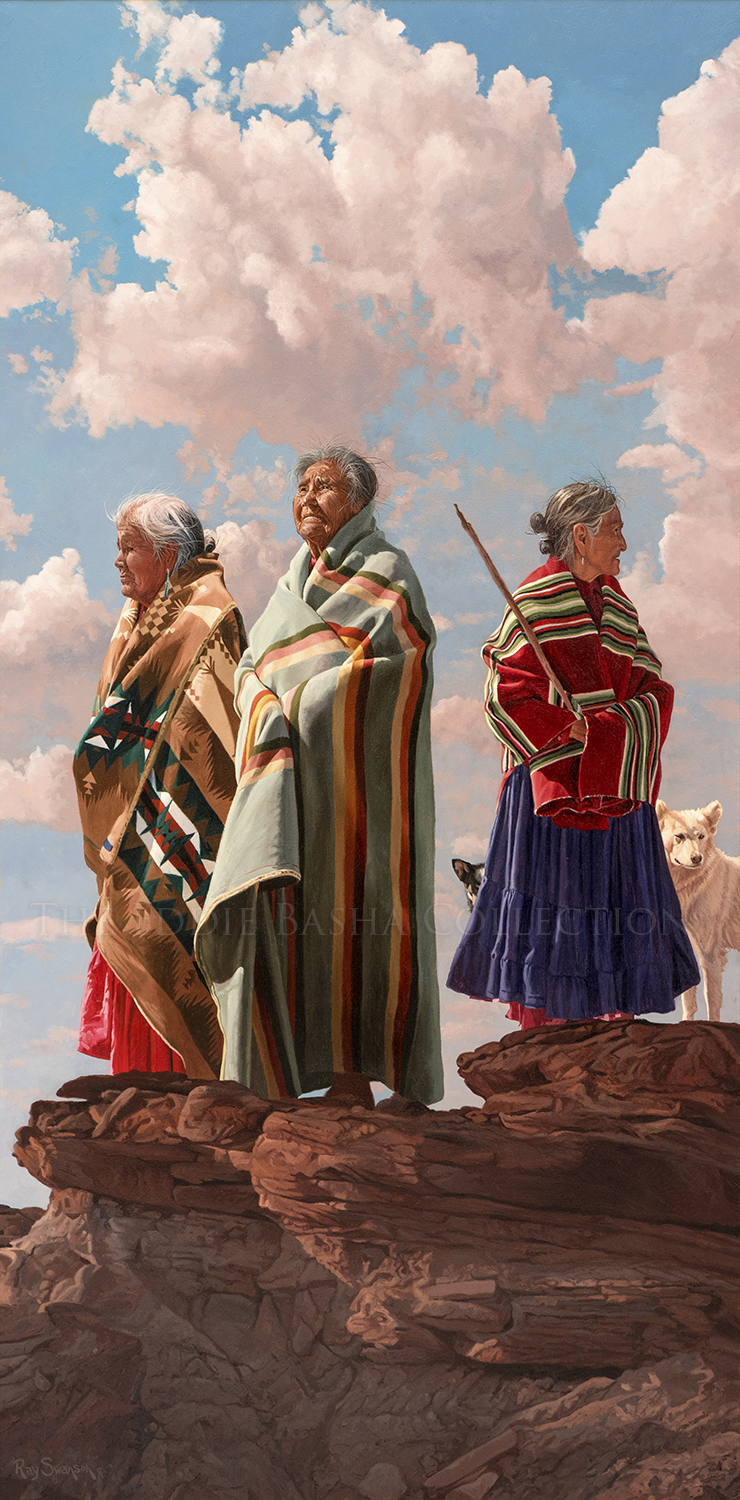
Blankets of the Dineh
Artist: Ray Swanson, CA (1937-2004)
Description: Oil (2004) | Image Size: 72”h x 36”w; Framed Size: 91”h x 55”wpainting
This striking, full-length portrait of three Navajo women standing against a brilliant blue sky dotted with white clouds is an excellent example of Ray Swanson’s realistic technique, attention to detail and accuracy, and his great sense of color. The three women wrapped in traditional multi-colored Navajo blankets stand proudly on an outcropping of red rocks with two dogs barely visible behind one of the women. The composition is dramatic with the two shorter women flanking the taller center figure and are shown in high relief contrast with the blue sky. The vibrant colors of their blankets command and hold the viewer’s attention.
Swanson painted individuals that he met on his many visits to reservations, often painting members of the same family over the course of several years. He has perfectly captured the likeness and personalities of these women who stand proudly as representatives of their culture. Their life experiences are etched in the lines of their faces.
“Blankets of the Dineh” made its debut at the 39th Annual Cowboy Artists of America Show & Sale in 2004 at the Phoenix Art Museum and was selected and printed as a poster the following year. Subsequently it has also been exhibited at the Phippen Museum 2008 (Prescott AZ) and the Booth Western Art Museum 2015 (Cartersville GA).
Unknown Title
Artist: Ray Swanson, CA (1937-2004)
Description: Oil | Image Size: 5”h x 7”w; Framed Size: 11 ½”h x 13 ½”wpainting
This Ray Swanson diminutive profile portrait of a Diné, meaning Navajo, man wearing an embellished hat, ceremonial velvet shirt, a chunky turquoise neckpiece and earrings also features a tsiiyéé, the sacred hair bun worn by men and women alike. The way the bun is constructed, the way it sits on the head, and the wrap used is part of the culture’s spiritual practice. Though small, this portrait is full of compelling details.
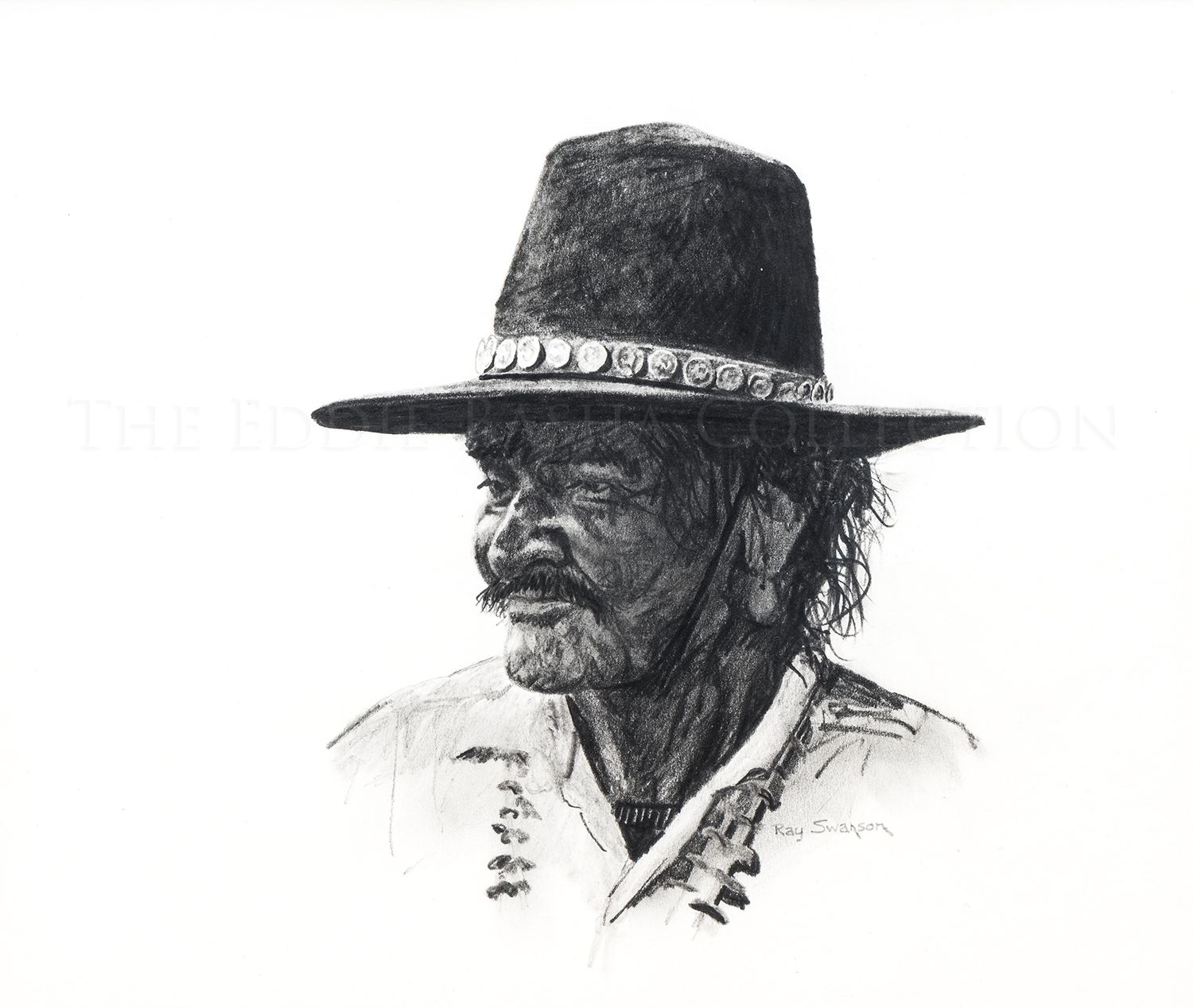
Unknown Title
Artist: Ray Swanson, CA (1937-2004)
Description: Pencil | Image Size: 7”h x 8”w; Frame Size: 13”h x 14”wdrawing
Whether working in oil, watercolor, or pencil, Ray Swanson had a great talent for painting American Indian portraits that show a depth of emotion, a unique personality, and a life full of experiences. His portraits go beyond a mere reproduction of someone’s face, but capture the soul behind the subject’s eyes. Swanson’s portraits, even a small one such as this, are deeply revealing tributes to specific individuals whom he met and befriended.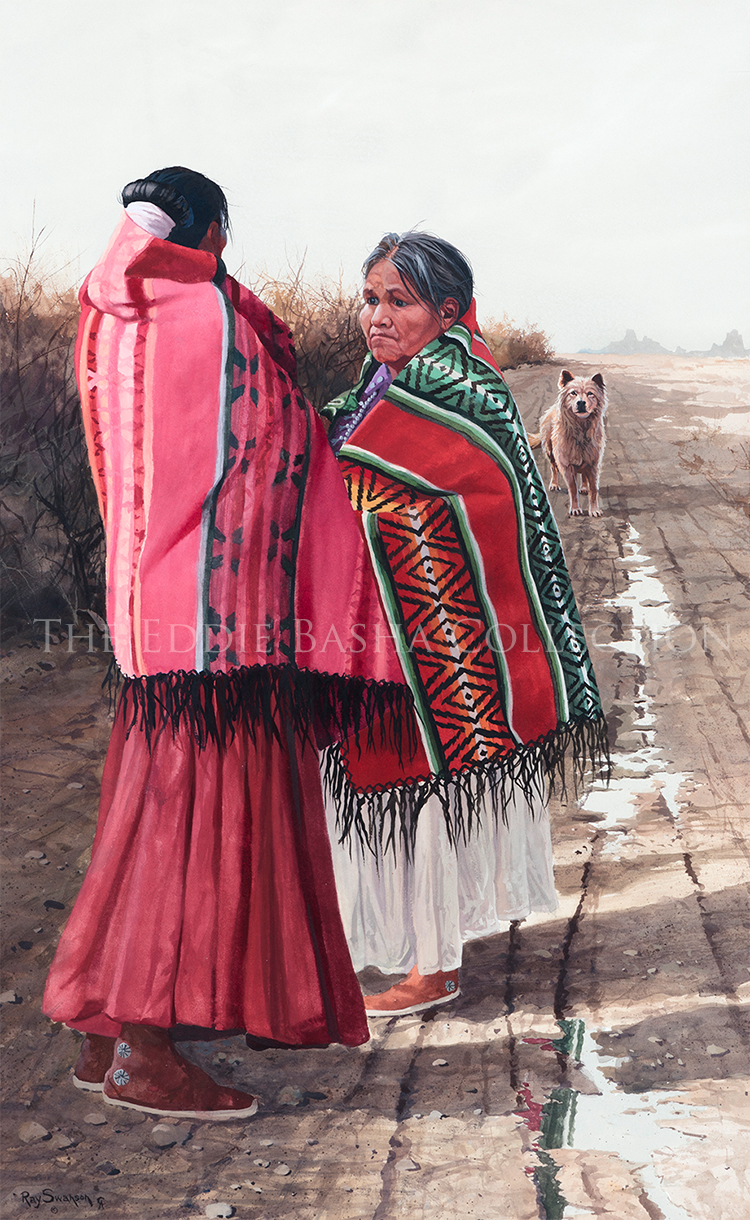
Where Paths Cross
Artist: Ray Swanson, CA (1937-2004)
Description: Gouache (2002) | Image Size: 28”h x 18”w; Framed Size: 37”h x 27”wpainting
Ray Swanson spent decades traveling to the Navajo reservation to gather inspiration and subject matter for his art. He showed life on the reservation as it actually was, on a day in and day out basis. Occasionally, he would slip in a bit of humor in his art.
In this painting, two women have met an unexpected visitor who is blocking the path they are on—a stray dog that is no doubt just as surprised at seeing them and as they are seeing him. The women are wearing colorful Navajo blankets and occupy the majority of the canvas. One watches with trepidation down the path they are following to see the stray standing further ahead giving the women a curious look. An unexpected impasse—just who will make the next move is anyone’s guess.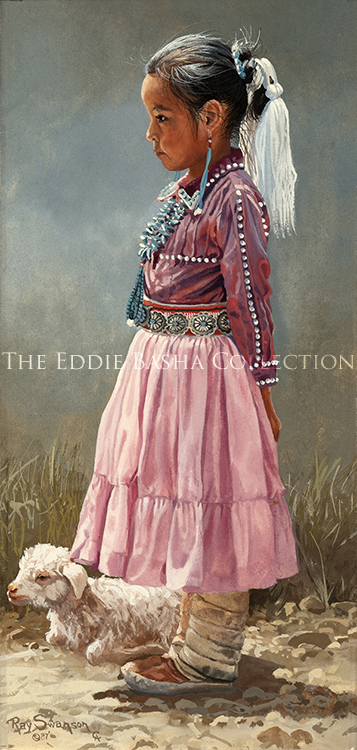
Pink Magenta
Artist: Ray Swanson, CA (1937-2004)
Description: Watercolor (1987) | Image Size: 12”h x 6”w; Framed Size: 18 5/8”h x 12 5/8”wpainting
Ray Swanson had a special affinity for American Indian cultures, most especially for Navajo elders and children. He painted all with sensitivity and was adept at capturing personalities, humor and everyday life. In this lovely watercolor, “Pink Magenta”, Ray’s appreciation for traditional Navajo dress and the grace and charm as it is worn by the beautiful young girl are quite apparent. Ray was a member of both the Cowboy Artists of America and the American Watercolor Society.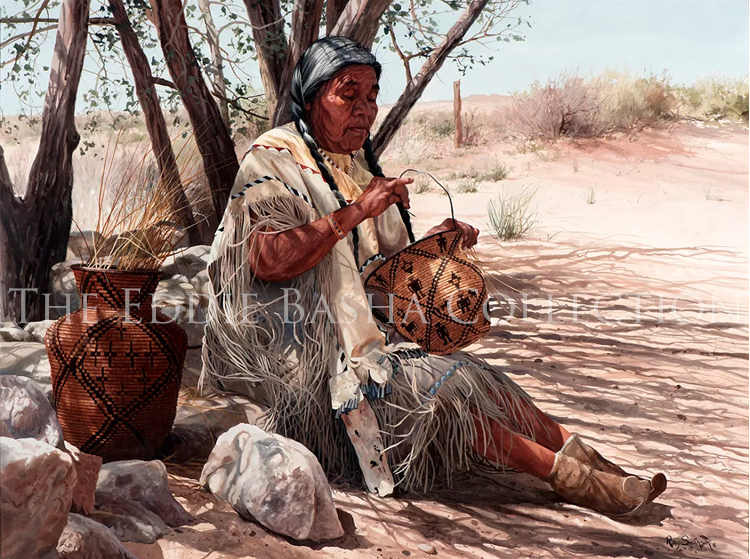
Weaving A Tradition
Artist: Ray Swanson, CA (1937-2004)
Description: Opaque Watercolor (1994) | Image Size: 30”h x 40”w; Framed Size: 41.25”h x 51”wpainting
In 1994, Ray Swanson won both the Gold Medal in the Water Soluble category for “Weaving A Tradition” and the Artists Choice Award for his body of work at the 29th Annual Cowboy Artists of America Exhibition & Sale held at the Phoenix Art Museum.
One of the recurring themes in Ray Swanson’s art is the continuation of traditions and transfer of knowlege from one generation to another. In this painting of an Indian woman weaving a basket, Swanson focuses on how traditional crafts still have a place in modern Native American society. The woman seated under the shade of a tree is engaged in the same task that her ancestors practiced. She is using the same material to weave the basket and follows a pattern of traditional designs. Swanson’s landscape is realistically presented and features the neutral tones of the Southwestern desert. His weaver intently concentrates on the task at hand. As with many of Swanson’s subjects, her face shows a wealth of life experiences.
Moonlight Ride
Artist: Ray Swanson, CA (1937-2004)
Description: Watercolor (1991) | Image Size: 8”h x 14”w; Framed Size: 14 3/4"h x 20 3/4"wpainting
Primarily known for his paintings of Native Americans such as this lone Navajo rider on a white horse making his way across a rough, rocky terrain on a moonlit night. The action is quiet in the painting with a greater emphasis on setting a mood than conveying a sense of movement. The moonlight is effectively reflected off of the horse and the rider’s white hat.
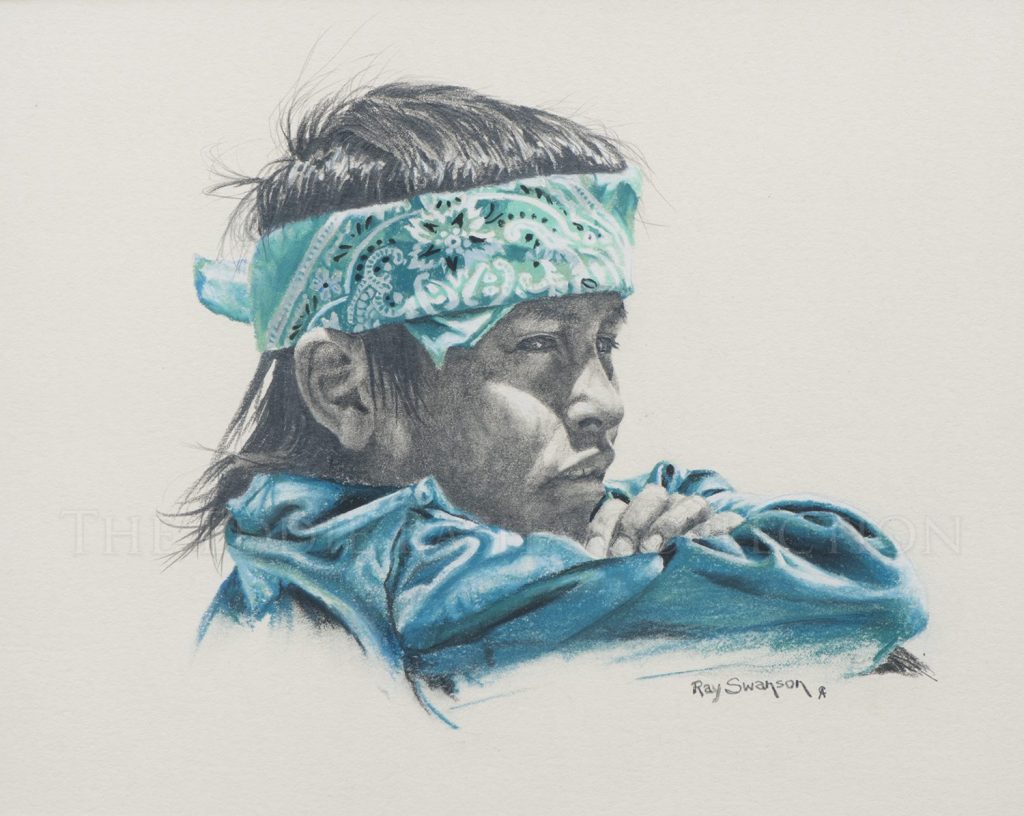 Mixed Media (1991) | Image Size: 8”h x 10”w; Framed Size: 16 ½”h x 18 ½”w
Mixed Media (1991) | Image Size: 8”h x 10”w; Framed Size: 16 ½”h x 18 ½”w This is a small, but exquisite portrait of one of Ray Swanson’s favorite models, Jason Begay, who at the time this piece was completed was the only boy in a family
of five sisters who has handsome, classic Navajo features and loves to model.
Swanson’s technique of drawing the boy’s face, hair, and hands in pencil and then contrasting those areas with a vibrant turquoise blue bandana and traditional Navajo
velvet shirt adds tremendous depth to the facial features. We focus on Jason’s face even more so because the blue serves to frame it. The young man’s personality and emotions have been expertly captured.
“Young Mr. Begay” made its debut at the 26th
Annual Cowboy Artists of America Show & Sale held at the Phoenix Art Museum in 1991. It was subsequently purchased by Eddie Basha at an auction in 2005.
Young Mr. Begay
Artist: Ray Swanson, CA (1937-2004)
Description:
Mixed Media (1991) | Image Size: 8”h x 10”w; Framed Size: 16 ½”h x 18 ½”w
This is a small, but exquisite portrait of one of Ray Swanson’s favorite models, Jason Begay, who at the time this piece was completed was the only boy in a family
of five sisters who has handsome, classic Navajo features and loves to model.
Swanson’s technique of drawing the boy’s face, hair, and hands in pencil and then contrasting those areas with a vibrant turquoise blue bandana and traditional Navajo
velvet shirt adds tremendous depth to the facial features. We focus on Jason’s face even more so because the blue serves to frame it. The young man’s personality and emotions have been expertly captured.
“Young Mr. Begay” made its debut at the 26th
Annual Cowboy Artists of America Show & Sale held at the Phoenix Art Museum in 1991. It was subsequently purchased by Eddie Basha at an auction in 2005.
paintingThis is a small, but exquisite portrait of one of Ray Swanson’s favorite models, Jason Begay, who at the time this piece was completed was the only boy in a family
of five sisters who has handsome, classic Navajo features and loves to model.
Swanson’s technique of drawing the boy’s face, hair, and hands in pencil and then contrasting those areas with a vibrant turquoise blue bandana and traditional Navajo
velvet shirt adds tremendous depth to the facial features. We focus on Jason’s face even more so because the blue serves to frame it. The young man’s personality and emotions have been expertly captured.
“Young Mr. Begay” made its debut at the 26th
Annual Cowboy Artists of America Show & Sale held at the Phoenix Art Museum in 1991. It was subsequently purchased by Eddie Basha at an auction in 2005.
 Gouache | Image Size: 15”h x 12”w; Framed Size: 23”h x 20”w
Gouache | Image Size: 15”h x 12”w; Framed Size: 23”h x 20”wCowboy Artists of America Member Ray Swanson’s black and white study of a Navajo elder is an excellent example of Swanson’s ability to capture personality and character by concentrating on facial features presenting a somber, but dignified demeanor. With the subject’s head cast downward, the viewer sees a full view of his hair, headwrap and a many-seasoned face.
Unknown Title
Artist: Ray Swanson, CA (1937-2004)
Description:
Gouache | Image Size: 15”h x 12”w; Framed Size: 23”h x 20”w
Cowboy Artists of America Member Ray Swanson’s black and white study of a Navajo elder is an excellent example of Swanson’s ability to capture personality and character by concentrating on facial features presenting a somber, but dignified demeanor. With the subject’s head cast downward, the viewer sees a full view of his hair, headwrap and a many-seasoned face.
paintingCowboy Artists of America Member Ray Swanson’s black and white study of a Navajo elder is an excellent example of Swanson’s ability to capture personality and character by concentrating on facial features presenting a somber, but dignified demeanor. With the subject’s head cast downward, the viewer sees a full view of his hair, headwrap and a many-seasoned face.
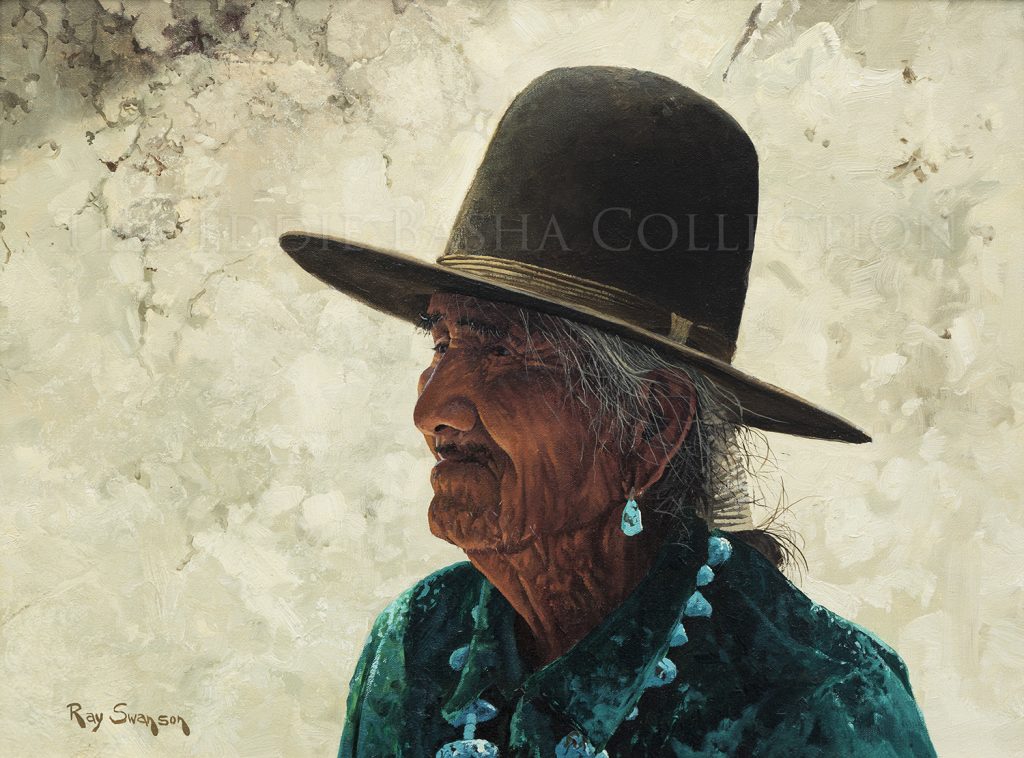 Oil | Image Size: 18”h x 24”w; Framed Size: 28”h x 34”w
Oil | Image Size: 18”h x 24”w; Framed Size: 28”h x 34”wRay Swanson said on many occasions that his greatest challenge and greatest reward was to capture the many emotions and experiences expressed in the faces of his subjects. In this profile portrait of a Navajo man wearing a traditional hat and turquoise jewelry, Swanson met that challenge. His portrayal of this senior citizen captured not only the gentleman’s dignity, but his lifetime of unique experiences.
Navajo From Dennehotso
Artist: Ray Swanson, CA (1937-2004)
Description:
Oil | Image Size: 18”h x 24”w; Framed Size: 28”h x 34”w
Ray Swanson said on many occasions that his greatest challenge and greatest reward was to capture the many emotions and experiences expressed in the faces of his subjects. In this profile portrait of a Navajo man wearing a traditional hat and turquoise jewelry, Swanson met that challenge. His portrayal of this senior citizen captured not only the gentleman’s dignity, but his lifetime of unique experiences.
paintingRay Swanson said on many occasions that his greatest challenge and greatest reward was to capture the many emotions and experiences expressed in the faces of his subjects. In this profile portrait of a Navajo man wearing a traditional hat and turquoise jewelry, Swanson met that challenge. His portrayal of this senior citizen captured not only the gentleman’s dignity, but his lifetime of unique experiences.
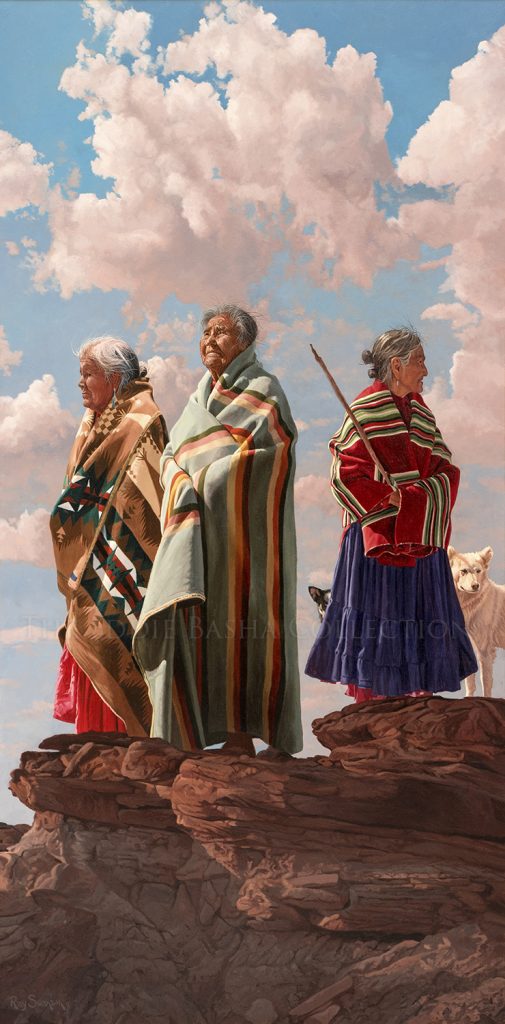 Oil (2004) | Image Size: 72”h x 36”w; Framed Size: 91”h x 55”w
Oil (2004) | Image Size: 72”h x 36”w; Framed Size: 91”h x 55”wThis striking, full-length portrait of three Navajo women standing against a brilliant blue sky dotted with white clouds is an excellent example of Ray Swanson’s realistic technique, attention to detail and accuracy, and his great sense of color. The three women wrapped in traditional multi-colored Navajo blankets stand proudly on an outcropping of red rocks with two dogs barely visible behind one of the women. The composition is dramatic with the two shorter women flanking the taller center figure and are shown in high relief contrast with the blue sky. The vibrant colors of their blankets command and hold the viewer’s attention.
Swanson painted individuals that he met on his many visits to reservations, often painting members of the same family over the course of several years. He has perfectly captured the likeness and personalities of these women who stand proudly as representatives of their culture. Their life experiences are etched in the lines of their faces.
“Blankets of the Dineh” made its debut at the 39th Annual Cowboy Artists of America Show & Sale in 2004 at the Phoenix Art Museum and was selected and printed as a poster the following year. Subsequently it has also been exhibited at the Phippen Museum 2008 (Prescott AZ) and the Booth Western Art Museum 2015 (Cartersville GA).
Blankets of the Dineh
Artist: Ray Swanson, CA (1937-2004)
Description:
Oil (2004) | Image Size: 72”h x 36”w; Framed Size: 91”h x 55”w
This striking, full-length portrait of three Navajo women standing against a brilliant blue sky dotted with white clouds is an excellent example of Ray Swanson’s realistic technique, attention to detail and accuracy, and his great sense of color. The three women wrapped in traditional multi-colored Navajo blankets stand proudly on an outcropping of red rocks with two dogs barely visible behind one of the women. The composition is dramatic with the two shorter women flanking the taller center figure and are shown in high relief contrast with the blue sky. The vibrant colors of their blankets command and hold the viewer’s attention.
Swanson painted individuals that he met on his many visits to reservations, often painting members of the same family over the course of several years. He has perfectly captured the likeness and personalities of these women who stand proudly as representatives of their culture. Their life experiences are etched in the lines of their faces.
“Blankets of the Dineh” made its debut at the 39th Annual Cowboy Artists of America Show & Sale in 2004 at the Phoenix Art Museum and was selected and printed as a poster the following year. Subsequently it has also been exhibited at the Phippen Museum 2008 (Prescott AZ) and the Booth Western Art Museum 2015 (Cartersville GA).
paintingThis striking, full-length portrait of three Navajo women standing against a brilliant blue sky dotted with white clouds is an excellent example of Ray Swanson’s realistic technique, attention to detail and accuracy, and his great sense of color. The three women wrapped in traditional multi-colored Navajo blankets stand proudly on an outcropping of red rocks with two dogs barely visible behind one of the women. The composition is dramatic with the two shorter women flanking the taller center figure and are shown in high relief contrast with the blue sky. The vibrant colors of their blankets command and hold the viewer’s attention.
Swanson painted individuals that he met on his many visits to reservations, often painting members of the same family over the course of several years. He has perfectly captured the likeness and personalities of these women who stand proudly as representatives of their culture. Their life experiences are etched in the lines of their faces.
“Blankets of the Dineh” made its debut at the 39th Annual Cowboy Artists of America Show & Sale in 2004 at the Phoenix Art Museum and was selected and printed as a poster the following year. Subsequently it has also been exhibited at the Phippen Museum 2008 (Prescott AZ) and the Booth Western Art Museum 2015 (Cartersville GA).
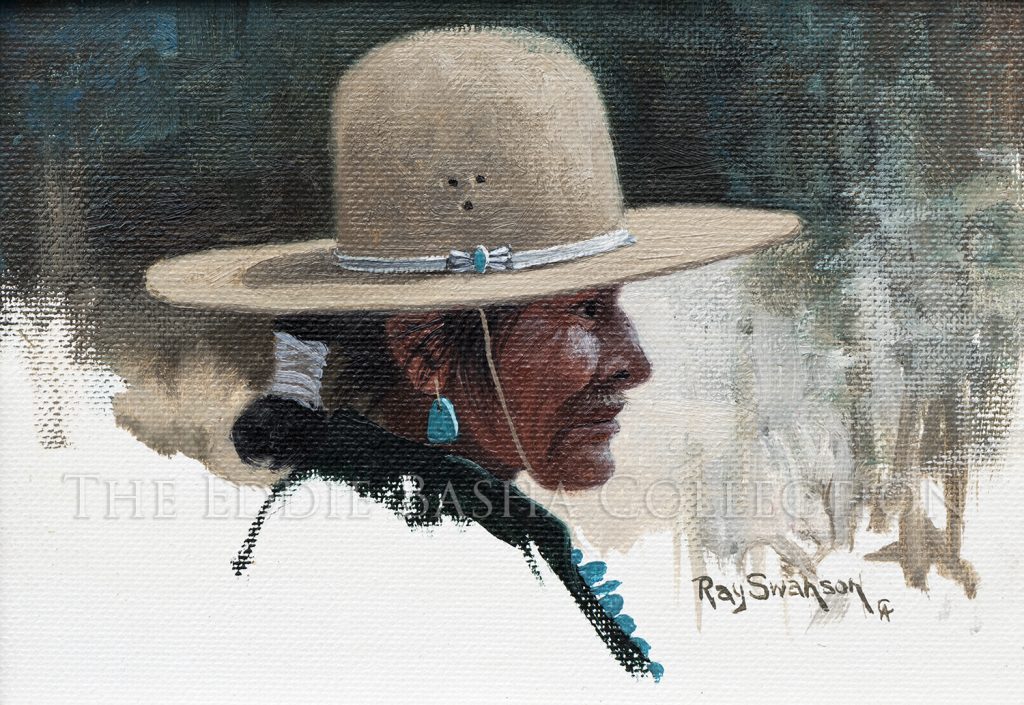 Oil | Image Size: 5”h x 7”w; Framed Size: 11 ½”h x 13 ½”w
Oil | Image Size: 5”h x 7”w; Framed Size: 11 ½”h x 13 ½”wThis Ray Swanson diminutive profile portrait of a Diné, meaning Navajo, man wearing an embellished hat, ceremonial velvet shirt, a chunky turquoise neckpiece and earrings also features a tsiiyéé, the sacred hair bun worn by men and women alike. The way the bun is constructed, the way it sits on the head, and the wrap used is part of the culture’s spiritual practice. Though small, this portrait is full of compelling details.
Unknown Title
Artist: Ray Swanson, CA (1937-2004)
Description:
Oil | Image Size: 5”h x 7”w; Framed Size: 11 ½”h x 13 ½”w
This Ray Swanson diminutive profile portrait of a Diné, meaning Navajo, man wearing an embellished hat, ceremonial velvet shirt, a chunky turquoise neckpiece and earrings also features a tsiiyéé, the sacred hair bun worn by men and women alike. The way the bun is constructed, the way it sits on the head, and the wrap used is part of the culture’s spiritual practice. Though small, this portrait is full of compelling details.
paintingThis Ray Swanson diminutive profile portrait of a Diné, meaning Navajo, man wearing an embellished hat, ceremonial velvet shirt, a chunky turquoise neckpiece and earrings also features a tsiiyéé, the sacred hair bun worn by men and women alike. The way the bun is constructed, the way it sits on the head, and the wrap used is part of the culture’s spiritual practice. Though small, this portrait is full of compelling details.
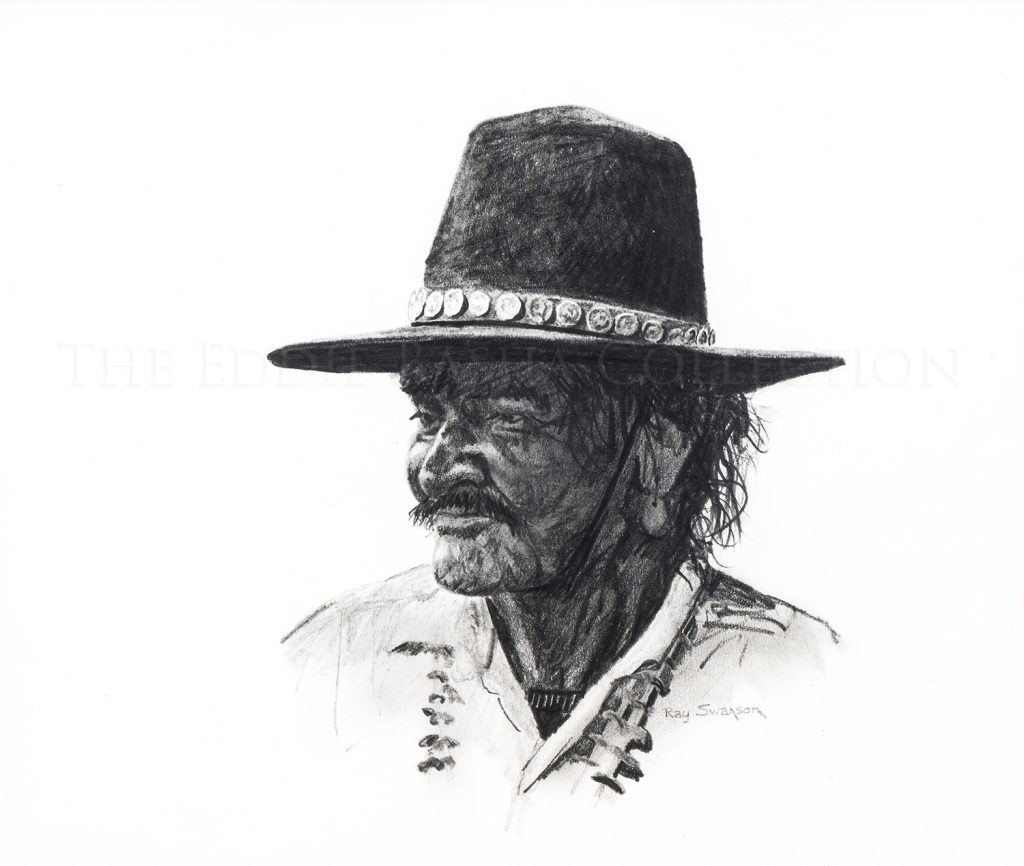 Pencil | Image Size: 7”h x 8”w; Frame Size: 13”h x 14”w
Pencil | Image Size: 7”h x 8”w; Frame Size: 13”h x 14”wWhether working in oil, watercolor, or pencil, Ray Swanson had a great talent for painting American Indian portraits that show a depth of emotion, a unique personality, and a life full of experiences. His portraits go beyond a mere reproduction of someone’s face, but capture the soul behind the subject’s eyes. Swanson’s portraits, even a small one such as this, are deeply revealing tributes to specific individuals whom he met and befriended.
Unknown Title
Artist: Ray Swanson, CA (1937-2004)
Description:
Pencil | Image Size: 7”h x 8”w; Frame Size: 13”h x 14”w
Whether working in oil, watercolor, or pencil, Ray Swanson had a great talent for painting American Indian portraits that show a depth of emotion, a unique personality, and a life full of experiences. His portraits go beyond a mere reproduction of someone’s face, but capture the soul behind the subject’s eyes. Swanson’s portraits, even a small one such as this, are deeply revealing tributes to specific individuals whom he met and befriended.
drawingWhether working in oil, watercolor, or pencil, Ray Swanson had a great talent for painting American Indian portraits that show a depth of emotion, a unique personality, and a life full of experiences. His portraits go beyond a mere reproduction of someone’s face, but capture the soul behind the subject’s eyes. Swanson’s portraits, even a small one such as this, are deeply revealing tributes to specific individuals whom he met and befriended.
 Gouache (2002) | Image Size: 28”h x 18”w; Framed Size: 37”h x 27”w
Gouache (2002) | Image Size: 28”h x 18”w; Framed Size: 37”h x 27”wRay Swanson spent decades traveling to the Navajo reservation to gather inspiration and subject matter for his art. He showed life on the reservation as it actually was, on a day in and day out basis. Occasionally, he would slip in a bit of humor in his art.
In this painting, two women have met an unexpected visitor who is blocking the path they are on—a stray dog that is no doubt just as surprised at seeing them and as they are seeing him. The women are wearing colorful Navajo blankets and occupy the majority of the canvas. One watches with trepidation down the path they are following to see the stray standing further ahead giving the women a curious look. An unexpected impasse—just who will make the next move is anyone’s guess.
Where Paths Cross
Artist: Ray Swanson, CA (1937-2004)
Description:
Gouache (2002) | Image Size: 28”h x 18”w; Framed Size: 37”h x 27”w
Ray Swanson spent decades traveling to the Navajo reservation to gather inspiration and subject matter for his art. He showed life on the reservation as it actually was, on a day in and day out basis. Occasionally, he would slip in a bit of humor in his art.
In this painting, two women have met an unexpected visitor who is blocking the path they are on—a stray dog that is no doubt just as surprised at seeing them and as they are seeing him. The women are wearing colorful Navajo blankets and occupy the majority of the canvas. One watches with trepidation down the path they are following to see the stray standing further ahead giving the women a curious look. An unexpected impasse—just who will make the next move is anyone’s guess.
paintingRay Swanson spent decades traveling to the Navajo reservation to gather inspiration and subject matter for his art. He showed life on the reservation as it actually was, on a day in and day out basis. Occasionally, he would slip in a bit of humor in his art.
In this painting, two women have met an unexpected visitor who is blocking the path they are on—a stray dog that is no doubt just as surprised at seeing them and as they are seeing him. The women are wearing colorful Navajo blankets and occupy the majority of the canvas. One watches with trepidation down the path they are following to see the stray standing further ahead giving the women a curious look. An unexpected impasse—just who will make the next move is anyone’s guess.
 Watercolor (1987) | Image Size: 12”h x 6”w; Framed Size: 18 5/8”h x 12 5/8”w
Watercolor (1987) | Image Size: 12”h x 6”w; Framed Size: 18 5/8”h x 12 5/8”wRay Swanson had a special affinity for American Indian cultures, most especially for Navajo elders and children. He painted all with sensitivity and was adept at capturing personalities, humor and everyday life. In this lovely watercolor, “Pink Magenta”, Ray’s appreciation for traditional Navajo dress and the grace and charm as it is worn by the beautiful young girl are quite apparent. Ray was a member of both the Cowboy Artists of America and the American Watercolor Society.
Pink Magenta
Artist: Ray Swanson, CA (1937-2004)
Description:
Watercolor (1987) | Image Size: 12”h x 6”w; Framed Size: 18 5/8”h x 12 5/8”w
Ray Swanson had a special affinity for American Indian cultures, most especially for Navajo elders and children. He painted all with sensitivity and was adept at capturing personalities, humor and everyday life. In this lovely watercolor, “Pink Magenta”, Ray’s appreciation for traditional Navajo dress and the grace and charm as it is worn by the beautiful young girl are quite apparent. Ray was a member of both the Cowboy Artists of America and the American Watercolor Society.
paintingRay Swanson had a special affinity for American Indian cultures, most especially for Navajo elders and children. He painted all with sensitivity and was adept at capturing personalities, humor and everyday life. In this lovely watercolor, “Pink Magenta”, Ray’s appreciation for traditional Navajo dress and the grace and charm as it is worn by the beautiful young girl are quite apparent. Ray was a member of both the Cowboy Artists of America and the American Watercolor Society.
 Opaque Watercolor (1994) | Image Size: 30”h x 40”w; Framed Size: 41.25”h x 51”w
Opaque Watercolor (1994) | Image Size: 30”h x 40”w; Framed Size: 41.25”h x 51”wIn 1994, Ray Swanson won both the Gold Medal in the Water Soluble category for “Weaving A Tradition” and the Artists Choice Award for his body of work at the 29th Annual Cowboy Artists of America Exhibition & Sale held at the Phoenix Art Museum.
One of the recurring themes in Ray Swanson’s art is the continuation of traditions and transfer of knowlege from one generation to another. In this painting of an Indian woman weaving a basket, Swanson focuses on how traditional crafts still have a place in modern Native American society. The woman seated under the shade of a tree is engaged in the same task that her ancestors practiced. She is using the same material to weave the basket and follows a pattern of traditional designs. Swanson’s landscape is realistically presented and features the neutral tones of the Southwestern desert. His weaver intently concentrates on the task at hand. As with many of Swanson’s subjects, her face shows a wealth of life experiences.
Weaving A Tradition
Artist: Ray Swanson, CA (1937-2004)
Description:
Opaque Watercolor (1994) | Image Size: 30”h x 40”w; Framed Size: 41.25”h x 51”w
In 1994, Ray Swanson won both the Gold Medal in the Water Soluble category for “Weaving A Tradition” and the Artists Choice Award for his body of work at the 29th Annual Cowboy Artists of America Exhibition & Sale held at the Phoenix Art Museum.
One of the recurring themes in Ray Swanson’s art is the continuation of traditions and transfer of knowlege from one generation to another. In this painting of an Indian woman weaving a basket, Swanson focuses on how traditional crafts still have a place in modern Native American society. The woman seated under the shade of a tree is engaged in the same task that her ancestors practiced. She is using the same material to weave the basket and follows a pattern of traditional designs. Swanson’s landscape is realistically presented and features the neutral tones of the Southwestern desert. His weaver intently concentrates on the task at hand. As with many of Swanson’s subjects, her face shows a wealth of life experiences.
paintingIn 1994, Ray Swanson won both the Gold Medal in the Water Soluble category for “Weaving A Tradition” and the Artists Choice Award for his body of work at the 29th Annual Cowboy Artists of America Exhibition & Sale held at the Phoenix Art Museum.
One of the recurring themes in Ray Swanson’s art is the continuation of traditions and transfer of knowlege from one generation to another. In this painting of an Indian woman weaving a basket, Swanson focuses on how traditional crafts still have a place in modern Native American society. The woman seated under the shade of a tree is engaged in the same task that her ancestors practiced. She is using the same material to weave the basket and follows a pattern of traditional designs. Swanson’s landscape is realistically presented and features the neutral tones of the Southwestern desert. His weaver intently concentrates on the task at hand. As with many of Swanson’s subjects, her face shows a wealth of life experiences.
 Watercolor (1991) | Image Size: 8”h x 14”w; Framed Size: 14 3/4"h x 20 3/4"w
Watercolor (1991) | Image Size: 8”h x 14”w; Framed Size: 14 3/4"h x 20 3/4"wPrimarily known for his paintings of Native Americans such as this lone Navajo rider on a white horse making his way across a rough, rocky terrain on a moonlit night. The action is quiet in the painting with a greater emphasis on setting a mood than conveying a sense of movement. The moonlight is effectively reflected off of the horse and the rider’s white hat.
Moonlight Ride
Artist: Ray Swanson, CA (1937-2004)
Description:
Watercolor (1991) | Image Size: 8”h x 14”w; Framed Size: 14 3/4"h x 20 3/4"w
Primarily known for his paintings of Native Americans such as this lone Navajo rider on a white horse making his way across a rough, rocky terrain on a moonlit night. The action is quiet in the painting with a greater emphasis on setting a mood than conveying a sense of movement. The moonlight is effectively reflected off of the horse and the rider’s white hat.
paintingPrimarily known for his paintings of Native Americans such as this lone Navajo rider on a white horse making his way across a rough, rocky terrain on a moonlit night. The action is quiet in the painting with a greater emphasis on setting a mood than conveying a sense of movement. The moonlight is effectively reflected off of the horse and the rider’s white hat.